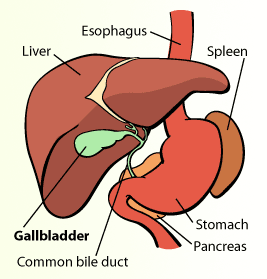Gallstone Disease
What causes gallstones?
 The gallbladder is a small sac found just under the liver, on the right side of the abdomen. The liver produces a liquid called bile, which is stored in the gallbladder. When a meal is eaten, the gallbladder contracts and releases the bile into the intestine. Bile is important because it helps digest the fat in foods. Gallstones can form in the gallbladder as a result of changes in diet or blood disorders, such as hereditary spherocytosis and sickle cell disease. Majority of children who have gallstones do not have any problems. However, when the gallstones cause a blockage in the flow of bile, problems can occur.
The gallbladder is a small sac found just under the liver, on the right side of the abdomen. The liver produces a liquid called bile, which is stored in the gallbladder. When a meal is eaten, the gallbladder contracts and releases the bile into the intestine. Bile is important because it helps digest the fat in foods. Gallstones can form in the gallbladder as a result of changes in diet or blood disorders, such as hereditary spherocytosis and sickle cell disease. Majority of children who have gallstones do not have any problems. However, when the gallstones cause a blockage in the flow of bile, problems can occur.
When the gallstones cause a blockage at the level of the neck of the gallbladder, the gallbladder gets distended, which leads to right upper quadrant pain and nausea when eating, especially fatty foods. The pain can resolve when the gallstone falls back into the body of gallbladder and the blockage goes away. This is called biliary colic. The pain can come and go. However, when the blockage does not go away, the pain continues, and the gallbladder gets so distended that it becomes inflamed and infected. This condition is called cholecystitis. When this occurs, your child will need to be admitted to the hospital.
When the gallstones cause a blockage at the level of the common bile duct, the bile duct gets distended, which can cause pain in the right upper quadrant and jaundice (yellow skin color). This condition is called choledocholithiasis. If an infection occurs within the bile duct secondary to the blockage, the condition is called cholangitis. In addition to pain and jaundice, your child may develop a fever and become very sick. Both conditions require hospital admission.
The gallstones can cause a blockage further down in the bile duct near where the pancreatic duct and bile duct empties into the intestine. If this occurs, the pancreatic duct can become blocked, causing the pancreatic enzymes to build up in the pancreas and leading to inflammation of the pancreas, called pancreatitis. In addition to epigastric pain and nausea, your child can become very sick and may need hospital admission.
How are gallstones diagnosed?
The presence of gallstones can be documented by ultrasound study. In addition, the ultrasound can demonstrate a dilated bile duct suggestive of a blockage in the bile duct. Additional imaging study called MRCP (magnetic resonance cholangiopancreatography) may be ordered to better evaluate the bile duct and locate the stone within the bile duct. For children with biliary colic, who are seen in clinic, ultrasound can be ordered by your child’s primary care provider. For other above-mentioned conditions (cholecystitis, choledocholithiasis, cholangitis, and pancreatitis), children are usually evaluated in the emergency department and require admission for further treatment.
How are gallstones treated?
A cholecystectomy is an operation to remove the gallbladder. Your child will be under general anesthesia for the operation. The gallbladder is not an essential organ and your child will do well after cholecystectomy. Once the gallbladder is removed, bile will continue to be released from the liver directly into the intestine with meals, but the gallstones will no longer form. Because gallstones cannot be removed without taking out the gallbladder, both the stones and the gallbladder are removed at the time of the operation.
In most cases, a cholecystectomy can be performed laparoscopically using a small telescope and tiny instruments placed through five band-aid sized incisions on the abdomen. The operation is usually completed in one to two hours. The urgency of the operation depends on your child’s symptoms and will be determined by the surgery team.
When the gallstones are blocking the bile duct, an additional procedure may be needed to help clear the bile duct, called ERCP (endoscopic retrograde cholangiopancreatography). This is endoscopic procedure where telescope is placed in the mouth, down to the stomach and intestine. A wire is used to enter the bile duct and swept clean the bile duct of stones. A sphincterotomy may also be done. The opening where the bile flows into the intestine is cut opened to allow additional stones to pass if needed. This procedure is also done under general anesthesia and may happen before or after cholecystectomy is performed. The procedure is done by a gastroenterologist.
How long will my child stay in the hospital?
Most children are ready to go home in one to two days after the operation. Your child will be able to eat, drink and be comfortable on pain medication taken by mouth (usually acetaminophen (Tylenol®) or ibuprofen (Motrin®)) before going home.
What to expect after surgery?
After cholecystectomy, some children can develop diarrhea or intolerance to certain foods as your child’s body adjust to the absence of gallbladder. If this occurs, over time (few months or so), your child will return to eating normal diet without any problems.
